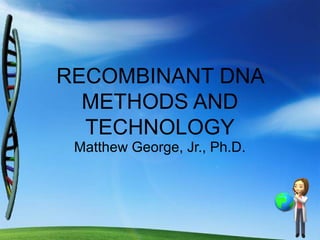
2012 recombinant dna methods and technology(1)
- 1. RECOMBINANT DNA METHODS AND TECHNOLOGY Matthew George, Jr., Ph.D.
- 2. Recombinant DNA and Genetic Engineering A recombinant DNA molecule is produced by splicing together DNA from different sources. It is usually done for one of the following reasons: To clone large amounts of DNA for the studies of gene organization; structure; sequencing; and gene regulation To genetically engineer cells in an organism to confer new desired characteristics (i.e., gene therapy, and correct genetic defects) To produce the product(s) of spliced genes in bacterial cells (i.e. insulin, human growth hormone) Alter the genetic characteristics of fruits and vegetables To produce organisms (i.e. Dolly, cows and mice for therapeutic purposes) STEM CELL RESEARCH: to produce new tissues and organs
- 4. Recombinant DNA Product Effect?
- 5. THE UTILITY OF RECOMBINANT DNA TECHNOLOGY
- 11. Basic components of a plasmid cloning vector that can replicate within an E. coli cell Molecular Cell Biology, 7th Edition, Lodish et al.
- 12. CLONING VECTORS
- 13. Structure of pBR322 - a common cloning vector • derived from a naturally occurring plasmid •has unique restriction enzyme cleavage sites for insertion of foreign DNA (100bp to 10kb) • has antibiotic resistance genes for selection of transformants containing the plasmid (insertion of DNA at these sites will result in the bacteria becoming sensitive to that antibiotic) •has origin of DNA replication (ori) for propagation in E. coli Fig. 7.7
- 14. Yeast Artificial Chromosome (YAC) Normal ends of eukaryotic chromosomes
- 15. DNA cloning in a plasmid vector permits amplification of a DNA fragment* See Devlin, fig. 7.9; *Molecular Cell Biology 7th Edition, Lodish et al.
- 17. Cloning a segment of DNA into a plasmid vect or Human DNA cut with PstI PstI P ampR tetR pBR322 ampR, tetR P P combine and ligate P tetR pBR322 DNA cut with PstI inactivating the amp R gene tetR pBR322 (human clone) tet R • bacteria are “transformed” with the recombinant plasmid • colonies that grow in tetracycline, but not in ampicillin are isolated
- 18. Antibiotic Selection R
- 19. cDNA Formation
- 21. A cDNA library contains representative copies of cellular mRNA sequences* See Devlin’s figure 7.16; *Molecular Cell Biology, 7th Edition, Lodish et al.
- 24. See fig. 7.13
- 26. Northern Blotting (Transfer of RNA from a gel to a solid matrix) Gives information about whether RNAs are present in a tissue. Often used to determine whether particular genes are expressed. Does NOT give information about whether the gene is present in other tissues. Presence of Glucokinase Human Liver Human Muscle Rat Brain E. coli ------
- 28. Expression Vectors Fig. 7.22
- 29. Some eukaryotic proteins can be produced in E. coli cells from plasmid vectors containing the lac promoter Molecular Cell Biology, 7th Edition, Lodish et al.
- 32. PCR
- 39. The CSI Effect
- 41. Sanger Dideoxy Sequencing Fig. 7.5
- 45. Transgenic animals - the gene of interest together with appropriate regulatory elements is microinjected into a fertilized mouse egg which is then inserted into the uterus of a foster mother mouse
- 54. Thank you for your time and patience; make us proud and good luck!!!
